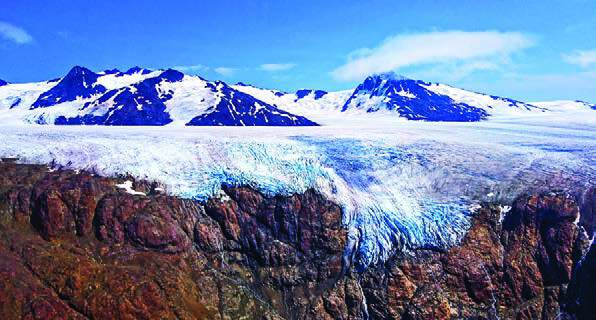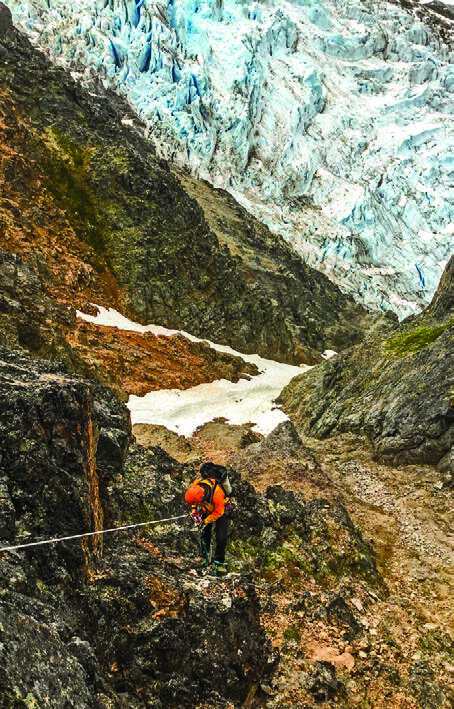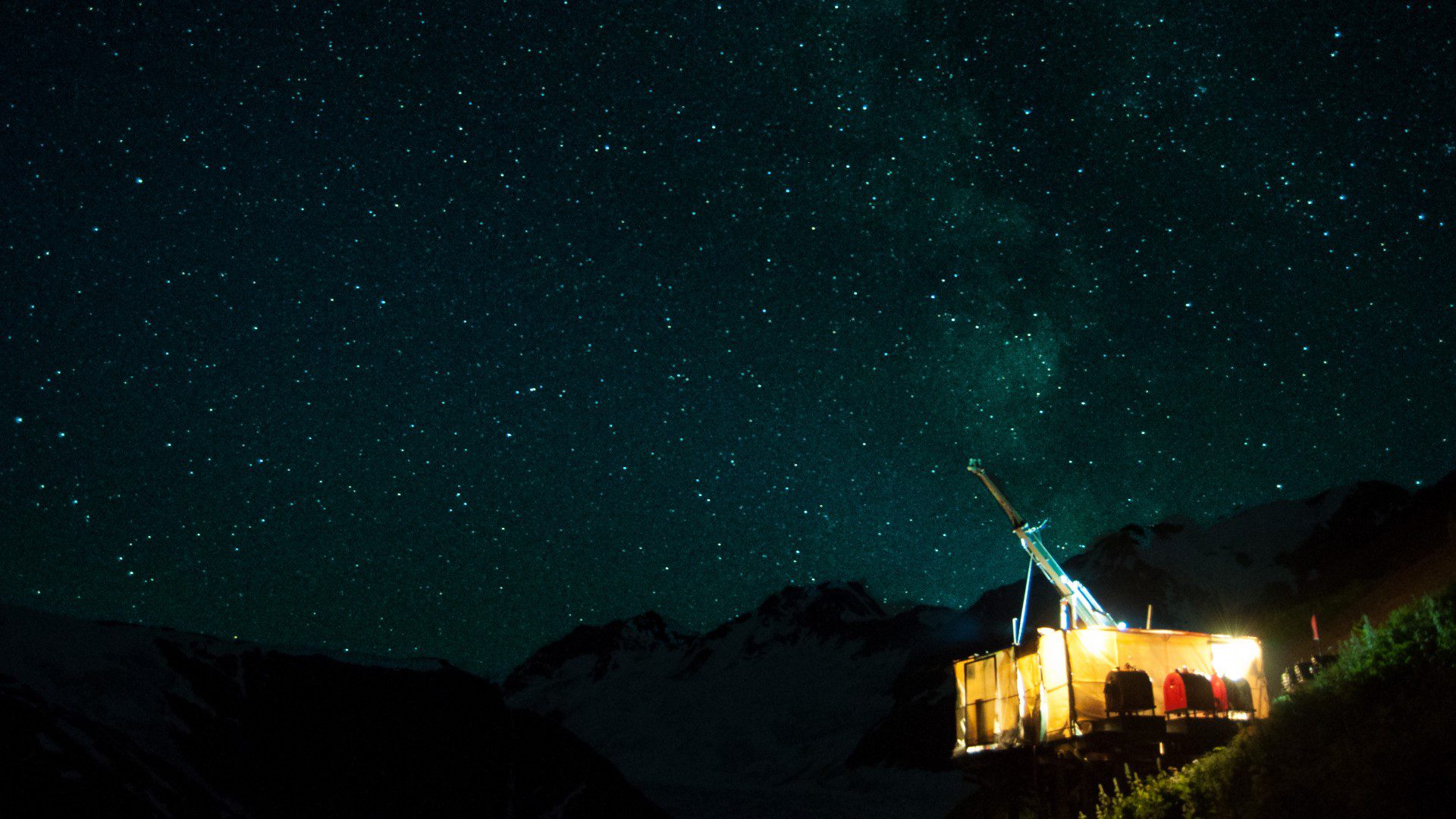
British Columbia is beautiful. Spectacular mountain ranges, rocky coastlines, rivers, forests, lakes, and grassy plains combine to create the picture-perfect landscapes we call home. But promising exploration targets are rarely found in the easy-to-reach places. Mineral exploration activities in this stunning terrain can be both difficult and dangerous and the changing climate is offering mineral explorers a tainted gift: Retreating glaciers are exposing fresh rock to explore, particularly in the Golden Triangle in the northwest of the province, and potential new targets are revealed each summer. In 2016, consultant geologist Andy Randell was working in Lost Valley, a prospective area to the south of the Red Mountain project near Stewart in northwest B.C. He was sent to examine a series of gold-bearing quartz veins that had last been mapped in 1984 and much of the map showed a white expanse simply labeled “ice.” This was no longer the case.

“Lost Valley has completely now lost its ice,” says Randell. “The Cambria Icefield has retreated at least two kilometres in 35 years, in my lifetime. The flipside of this glacial retreat is that everything is just scraped clean; there is no soil development, no vegetation. You get to see and sample rocks that no one has seen before.”
The team discovered rich gold mineralization in trenches and hand samples in Lost Valley but steered well clear of the steep, unstable back wall of the valley, where giant blocks of ice hung over the edge, “pinging and cracking” as they warmed, and on occasion, calving and falling. How can companies work safely in these steep, icy, and changing landscapes?
Increasingly they are calling in specialists with varied skill sets geared to operating in the most challenging terrain.
Rock-climbing geologists

Few jobs combine passion and profession like being a rock-climbing geologist. Exploration geologists Daniel Guestrin and Laurent Janssen met scaling a rock face in Quebec over five years ago. Soon after, the pair teamed up to form Steep Exploration, a company that provides mountain solutions for mineral exploration projects.
“We got our first contract five years ago,” said Guestrin. “They wanted two geologists to rappel down this steep mineralized hillside around Telegraph Creek in B.C. When Laurent and I finished this two week mapping job, we realized that we wanted to do more of it. And that’s how the company started.”
Guestrin and Janssen are often called in when a company can see a mineralized zone on a steep slope or find mineralized float on a traverse and want to trace it to the source. As geologists, they have the skills to map, collect samples and make observations, but as experienced and qualified mountaineers and avalanche professionals, they bring with them the knowledge, training, and gear to assess the terrain and safely access that out-of-reach outcrop.
“We know what to carry and how to access the target,” says Guestrin. “Some days we’re quite light with the basic glacier travel kit, and other days we have hundreds of metres of rope. Sometimes we carry well over 100 pounds of equipment to carry out the job.”
Safety is the priority for Guestrin and Janssen, who both have the highest level of wilderness first aid training, adhere to WorkSafe BC’s updated Rope Access Regulations and work closely with people certified by the Canadian Association of Mountain Guides.
The Steep Exploration team has been working in B.C.’s Golden Triangle for five years and know the rocks there very well. Although they have not noticed the change themselves, their clients have seen the changes in the glaciers and new ice-free ground open up.
“That’s where we come in,” said Guestrin. “Working around glaciers, you have a lot of hazards including crevasses, icefall hazards, and a lot of loose rock. If rock hasn’t been uncovered for a while by ice, then you can have a lot of rock fall. So it takes the right people to go to these areas where glacier retreat is happening.”

Operations in steep terrain
When larger teams of workers are operating on a steep slope to access a promising exploration target, additional specialists work in tandem to construct a safe structure. These include pilots, builders and drillers, geologists, safety specialists and, of course, various visitors. Preparing a remote site in steep terrain requires specific equipment and skill.
During the summer field season, Terracebased Axis Mountain Technical, specialists in remote mountain construction, work closely with mineral exploration, helicopter and drilling companies to facilitate exploration in steep terrain, including pad-building, slope stabilization, water systems, access roads and other necessary infrastructure. Ryan Foster, principal at Axis Mountain Technical, says that working around glaciers has a unique set of hazards.
“Most of the locations near glaciers are relatively newly exposed and there are all types of hazards that go along with that, including loose rock and overhead hazards,” says Foster. “We also help companies that are trying to explore and sample underneath the glaciers, so drilling, building drill pads on the glacier itself and on steep sections of ice, benching out the ice to enable a good pad construction.”
Advice from the pros
Involving the professionals early and often is critical when pushing into extreme terrain. “Understanding the hazards and coming up with a safe work plan is the first step,” says Foster. “It takes people who understand how that terrain behaves and the conditions that make it unsafe.” The Steep Exploration team agrees.
“We’re not out there to take risks,” says Janssen. “We’re there to mitigate hazards.”
